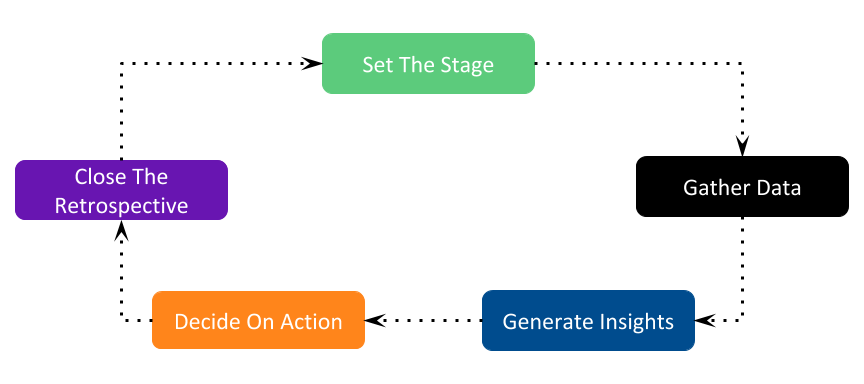Training For The Facilitator

Prerequisites#
Good facilitators tend to have a high level of emotional intelligence. This means they can easily read others' non-verbal cues to understand how individuals feel. They use this sense to cultivate an environment where everyone is comfortable speaking. Larger organizations may even have a guild of confident retrospective facilitators who coach individuals interested in learning how to facilitate retrospectives. These individuals include, but are not limited to, agile coaches, engineers, and project managers.
When searching for individuals in your organization to help facilitate retrospectives, look for those with these core competencies:
- Ability to read non-verbal cues to assess how people are feeling in the room to see who might have something to say.
- Can paraphrase what is said to clarify for self and others.
- Asks open-ended questions to stimulate deeper thinking.
- Is comfortable interrupting when discussion gets off track or someone dominates the discussion.
- Redirects discussion to focus on the team's goals.
- Keeps track of time and gives team members time reminders.
- Drives the discussion to making decisions and action items.
Retrospective facilitators do not need to be experts in the attending team's processes. They do not need to be well-versed in the content of the discussion. Remember, the facilitator does not contribute their own opinions about the discussion but works to get participants to think and speak. The retrospective participants are the experts on their work, and the facilitator asks the right questions to encourage them to share information with the team.
The facilitator should, however, be familiar with the retrospective process and the goals of the retrospective so they can guide the team's discussion to achieve set goals.
Responsibilities#
Read up on the role of the retrospective facilitator to see what is expected from them.
Training Process#
The process for training retrospective facilitators is constantly evolving. Here are things you can do to get started on developing your retrospective facilitation skills:
- Read this guide!
- Set up one-on-one time with an experienced retrospective facilitator in your organization to ask them questions.
- Shadow a retrospective to see how it's run.
- During the retrospective, observe and write down any questions you have for the facilitator.
- After the retrospective, have a debrief with the facilitator. Ask them your questions, focusing on understanding:
- Why the facilitator posed certain questions to retrospective participants.
- Why the facilitator gave the team more time to discuss some topics over others.
- Reverse shadow a retrospective facilitator.
- Facilitate the retrospective to the best of your ability.
- The experienced facilitator will also be there to support you if needed.
Graduation#
Once you're comfortable facilitating retrospectives independently, congratulations—you may now call yourself a retrospective facilitator!
Don't forget to inform teams requiring a retrospective facilitator that you're now available to support them.
Pocket Reference Guide#
Every retrospective is different, but there's a common process you can apply to each one.

Set the Stage#
Setting the stage involves establishing the purpose of the retrospective and warming the participants up for discussion. This preparation step will encourage every participant to participate later during the retrospective.
- Remind the participants why they're here. Say "The purpose of today's retrospective is to discuss what went well and what we could have done differently during the most recent work cadence/project X/etc."
- Warm up the participants for discussion. Ask "What's one word or one image to describe how you feel about the most recent work cadence/completed project?" Taking turns, each participant shares their sentiment and a brief explanation of their rationale.
Gather Data#
The next step is to gather data about the retrospective focus from the participants. This is an information-gathering step that reminds the participants of what they've recently come across in their work.
- Give participants individual brainstorming time. Say "Take X minutes to answer the guiding questions on Trello cards/sticky notes."
- Check in with the participants near the end of the timebox for brainstorming. Ask "We have X minutes left. Do you need a couple more minutes?"
Generate Insights#
After gathering the participants' data, it's time for them to discuss their topic/discussion ideas in more detail.
- Gather additional, relevant context from participants. Ask "Can you provide additional context behind what you've written on this Trello card/sticky note?" or "Why did this experience make you feel the way it did?"
- Stimulate deeper discussion about a topic as you deem appropriate. Ask the participants probing questions.
Decide on Action#
Once the participants have generated insights, they need to decide on what action to take to address their concerns and determine ownership of these actions.
- Shepherd the participants towards finding a few changes they can focus on. Ask: - "What can we do to improve a bad situation?" - "Is there a good situation that can be made better?" - "Is there a good situation we can replicate to do more good in another area of our work?"
- Document the action items generated by the participants. Make sure they're visible to the participants. If you're facilitating the participants' next retrospective, be sure to follow up on these action items to see what progress was made toward addressing the issue(s).
- Remind the participants to assign ownership to each action item they generate. Ask "Who will own this action item?" This holds the team accountable to accomplish what they had set out to do.
Close the Retrospective#
After action items have been determined and assigned, the facilitator wraps up the retrospective.
- Thank the participants. Say "Thanks for everyone's time and participation."
- Recap key information from the retrospective. Say "We discussed these major topics today and decided to carry out these action items."
- Review participants' appreciations for each other. Say "We'll go through everyone's appreciations one at a time now. When we get to your Trello card/sticky note, read your thank-you message aloud."
